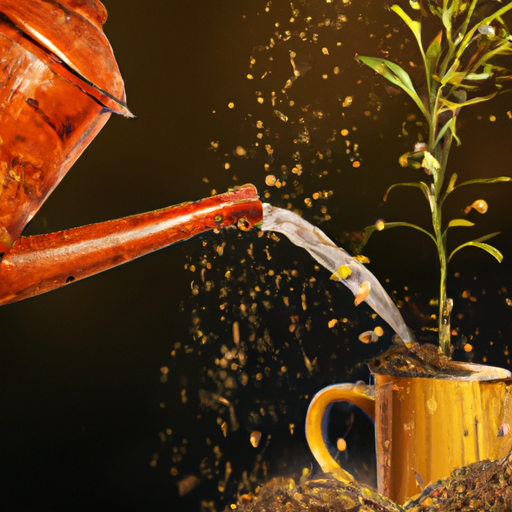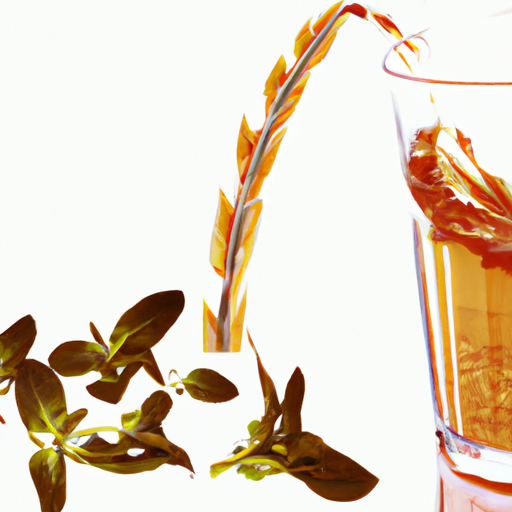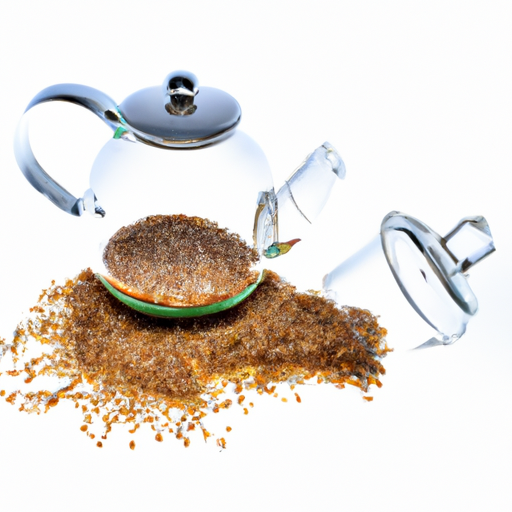The adage ‘you are what you eat’ holds true not just for humans but for plants as well. Ensuring they receive the proper nutrients is crucial for their development and health. Among the beneficial options, barley tea stands out as a nutrient-packed choice that can positively impact your plants in a variety of ways.
In this article, I will guide you through the process of making barley tea for your plants, so you can enjoy seeing them thrive. Barley tea is a natural and organic fertilizer that contains essential nutrients like nitrogen, phosphorus, and potassium. It also has trace elements like zinc, copper, and manganese that are crucial for plant growth.
The tea also acts as a natural fungicide, which can help prevent common fungal diseases in plants. Making barley tea is an easy and cost-effective way to provide your plants with these essential nutrients and protect them from diseases. So, let’s get started on how to make barley tea for plants.
Key Takeaways
- Barley tea is a natural and cost-effective fertilizer that contains essential nutrients and trace elements crucial for plant growth.
- To brew barley tea for plants, rinse barley thoroughly, simmer in water for 20-30 minutes, strain out barley, and dilute before applying to soil or as foliar spray.
- Timing and frequency of application should be based on plant needs, and tea should be used to improve soil health and encourage growth of beneficial microorganisms.
- Patience and consistency are necessary for optimal results, and every plant may require a different balance of tea.
Benefits of Using Barley Tea for Plants
You’ll be amazed at the benefits your plants will receive from using barley tea as a natural fertilizer! Barley tea is a great source of nitrogen, which is essential for the growth of plants. Nitrogen is one of the three major nutrients that plants need to grow, and it’s responsible for the development of healthy leaves and stems.
Using barley tea as a fertilizer can help you achieve healthier and more abundant plants. When it comes to using alternative plant fertilizers, barley tea is a great option. Unlike chemical fertilizers, barley tea is completely natural and won’t harm the environment or your plants.
Additionally, barley tea is a cost-effective option that’s easy to make at home. You can use it to fertilize a wide range of plants, including vegetable plants, fruit trees, and ornamental plants. Different types of plants require different levels of nitrogen, so it’s important to choose the right type of fertilizer for your specific plants.
Barley tea is a great option for plants that require a moderate amount of nitrogen, such as tomatoes, peppers, and strawberries. It can also be used to fertilize plants that require high levels of nitrogen, such as corn and leafy greens. Using barley tea as a natural fertilizer can help you achieve healthier, more productive plants without the use of chemicals.
Now, let’s move on to the next step and gather our materials.
Gather Your Materials
Once you’ve got everything you need, it’s a breeze to whip up a batch of this beneficial brew. Here are the materials needed and brewing techniques to get started:
-
Barley: The most important ingredient for making barley tea for plants is barley. Whole barley is readily available at health food stores or online. You can also use hulled barley, but it will take a bit longer to brew.
-
Water: You’ll need plenty of water, both for brewing the tea and for rinsing the barley. A good rule of thumb is to use one cup of barley for every gallon of water.
-
A pot: You’ll need a large pot to boil the water and barley in. Stainless steel or enamel pots are good choices.
-
A strainer or cheesecloth: Once the tea is brewed, you’ll need to strain out the barley. A fine mesh strainer or cheesecloth works well.
-
A container: You’ll need a container to store the brewed tea in. A large plastic bucket or glass jar with a lid are good options.
To brew barley tea for plants, start by rinsing the barley thoroughly in cold water. This will help remove any dust or debris that may be on the grains. Once the barley is rinsed, add it to a pot of boiling water and let it simmer for about 30 minutes.
After the tea has brewed, strain out the barley and let the tea cool before using it on your plants.
Rinsing the barley is an important step in the brewing process because it helps remove any impurities that can be harmful to your plants. Once the barley is rinsed, it’s ready to be brewed into a nutrient-rich tea that will benefit your plants in many ways.
Rinse the Barley
Before diving into the brewing process, don’t forget to give your barley a good rinse to ensure your plants are receiving the best possible nutrients for their growth. It’s essential to remove any dirt, dust, or debris that may have accumulated on the barley.
You can rinse the barley under running water or soak it in water for a few minutes before draining the water. Rinsing is a crucial step that helps to eliminate any impurities that may affect the quality of your barley tea. It also helps to soften the grains, making it easier for the plants to absorb the nutrients.
Soaking the barley is an alternative to rinsing, but it’s not recommended. Soaking can cause the barley to become waterlogged, which can lead to mold growth and spoilage.
Once you have rinsed the barley, it’s time to boil it in water to make the barley tea that your plants will love. By boiling the barley, the water will extract all the nutrients present in the grains, making it a potent fertilizer for your plants.
So, let’s move on to the next step and boil the barley and water to make the perfect barley tea for your plants.
Boil the Barley and Water
To create a nutrient-rich fertilizer for your garden, simply boil the rinsed barley and water together until it resembles a hearty stew that will nourish your plants like a warm bowl of soup on a cold winter day. This process is not only easy but also effective in enhancing the growth of your plants.
However, before starting the boiling process, it’s important to note that there are alternative brewing methods that can be used to achieve different flavor variations. Here are five alternative brewing methods that you can try:
- Roasting the barley before boiling it can give the tea a nutty aroma and flavor.
- Adding a few slices of ginger can give the tea a spicy kick.
- Using cold water instead of hot water can produce a milder flavor.
- Mixing barley with other grains such as corn, wheat, or rice can create a unique flavor profile.
- Adding a teaspoon of honey or sugar can give the tea a slightly sweet taste.
Once you have selected your preferred brewing method, it’s time to start boiling. Bring the barley and water to a boil over high heat, then reduce the heat and simmer for 20-30 minutes until the barley becomes soft and tender. The resulting barley tea can be used as a liquid fertilizer for your garden, providing your plants with essential nutrients to thrive.
Now that the barley is boiled, let’s move on to the next step of the process: reducing heat and simmering.
Reduce Heat and Simmer
Now, bring down the heat and let the mixture simmer for 20-30 minutes, allowing the flavors to meld together and the barley to fully absorb the water. Reducing the heat is essential at this stage to prevent the mixture from boiling over and burning. Simmering the barley tea for the appropriate amount of time ensures that the tea is fully infused with the barley flavor, and the water has extracted all the nutrients from it.
Simmering has its pros and cons when making barley tea for plants. On the one hand, simmering can help to release more nutrients from the barley into the water, which is beneficial for the plants. It also allows the tea to cool down to a temperature that is suitable for plants, preventing any damage to their roots. On the other hand, simmering for too long can cause the tea to become too strong, making it difficult for plants to absorb the nutrients. It can also cause the tea to lose its flavor if left simmering for too long.
When simmering the barley tea, it is important to keep an eye on it to prevent it from boiling over or burning. After 20-30 minutes, turn off the heat and allow the tea to cool down before straining. Once strained, the barley tea is ready to use on plants. In the next section, we will discuss how to strain the barley tea to ensure the best results for your plants.
Strain the Barley Tea
For the best results, strain your freshly brewed barley tea through a fine mesh strainer, allowing the liquid to flow through while capturing any remaining solids, leaving behind a smooth and clear liquid ready to nourish your garden.
There are different barley tea filtering techniques that you can use to strain your tea, depending on your preference and the equipment available to you. Here are some of the most common methods:
-
Using a Cheesecloth: If you don’t have a fine mesh strainer, you can use a cheesecloth to filter your barley tea. Simply place the cheesecloth over a bowl or pitcher, pour the tea over it, and let it strain through the cloth. You may need to fold the cheesecloth several times to achieve a fine enough mesh.
-
Using a Coffee Filter: Another option is to use a coffee filter to strain your barley tea. Place the filter over a cup or jar, pour the tea over it, and wait for it to filter through. This method may take longer than using a fine mesh strainer or cheesecloth, but it will produce a clear and sediment-free tea.
-
Using a Tea Infuser: If you have a tea infuser, you can use it to strain your barley tea. Simply place the tea leaves in the infuser, pour hot water over them, and let them steep for several minutes. Once the tea is ready, remove the infuser and discard the leaves. This method is ideal for small quantities of tea.
-
Using a Strainer: A fine mesh strainer is the most common tool used for straining barley tea. Simply place the strainer over a bowl or pitcher, pour the tea through it, and let it strain. This method is quick, easy, and effective.
Now that your barley tea is strained, it’s time to allow the tea to cool before using it to water your plants. It’s important to note that hot tea can damage plant roots, so wait until the tea reaches room temperature before using it.
Once cooled, your nutrient-rich barley tea is ready to nourish your garden and promote healthy plant growth.
Allow the Tea to Cool
Once the brewed liquid has cooled to room temperature, you can proceed to use the nutrient-rich barley tea to nourish your garden and help your plants thrive. But before you do that, it’s important to understand the uses for cooled barley tea. Besides being a wonderful fertilizer, cooled barley tea can also be used as a natural pest control method. Simply spray it directly on the leaves of your plants to deter pests such as aphids, mites, and whiteflies.
Temperature plays a crucial role in plant care and the use of barley tea is no exception. Using tea that is too hot can damage or even kill your plants. On the other hand, using tea that is too cold may not provide the full benefits of the nutrients that are present in the tea. Therefore, it’s important to allow the tea to cool to room temperature before using it on your plants.
Now that you understand the uses for cooled barley tea and why temperature is important, it’s time to move on to the next step of diluting the tea before use. Diluting the tea will ensure that the nutrients are spread evenly and not concentrated in one area, which could lead to burning or damaging your plants.
Dilute the Barley Tea
Before you start using the cooled tea, you’ll need to mix it with water to dilute its strength and avoid damaging your beloved green friends. Diluting the barley tea is essential because it makes sure that the plants get the right amount of nutrients without getting overwhelmed. Dilution also helps in preventing any potential damage to the plant’s leaves or roots.
One of the benefits of dilution is that you can adjust the strength of the barley tea according to the needs of your plants. Different plants will require different dilution ratios, depending on their size and growth stage. For example, young plants may need a more diluted version of the tea compared to established plants. Diluting the tea also ensures that the nutrients are evenly distributed throughout the soil.
When diluting the barley tea, the general rule is to use one part barley tea to ten parts water. However, this ratio can vary depending on the needs of your plants. For example, if you have young plants, you can use a more diluted version of the tea, such as one part barley tea to twenty parts water. For established plants, you can use a stronger ratio, such as one part barley tea to five parts water. It’s essential to experiment with different ratios to find the perfect balance for your plants.
Now that you’ve diluted the barley tea, it’s time to apply it to your plants. Applying the tea to the soil around the plant’s roots is the most effective way to ensure that the plant gets the nutrients it needs. Use a watering can or spray bottle to apply the tea gently. Remember not to overwater your plants, as too much water can wash away the nutrients.
Apply the Barley Tea to Your Plants
Now that we’ve prepared our barley tea, it’s time to apply it to our plants.
There are different methods of application, depending on the type of plant and its specific needs. For example, we can use a watering can to apply the tea directly to the soil or use a spray bottle to apply it to the leaves.
It’s important to consider the frequency of application as well, as some plants may require more frequent watering with the barley tea than others.
As we continue to care for our plants, we must keep these factors in mind to ensure their optimal growth and health.
Methods of application
To ensure your plants receive the benefits of barley tea, you can apply it directly to the soil or use it as a foliar spray. If you choose to use it as a foliar spray, mix the barley tea with water in a spray bottle and apply it to the leaves of your plants. Be sure to focus on the undersides of the leaves, as this is where many pests and diseases can hide. The barley tea will work as a natural insecticide and fungicide, protecting your plants from harm.
Alternatively, you can apply the barley tea to the soil around your plants. Simply pour the tea directly onto the soil, making sure to cover the root zone of each plant. The barley tea will help to improve soil health, encouraging the growth of beneficial microorganisms that will help your plants thrive.
By applying the tea directly to the soil, you’ll also reduce the risk of damaging your plants’ leaves with too much moisture. With these methods of application, you can rest assured that your plants will receive the full benefits of the barley tea. Now, let’s discuss how often you should apply it for optimal results.
Frequency of application
For optimal results, it’s important to determine how frequently you should apply the barley tea to your garden. The timing of application is crucial in ensuring your plants receive the nutrients they need.
It’s best to apply the barley tea during the growing season, which is usually from spring to fall. During this time, plants are actively growing and need more nutrients to thrive. Applying the tea once a week or every two weeks is a good starting point. However, the frequency of application will depend on the type of plants you have and their individual needs.
Overuse risks are also a consideration when determining how often to apply the barley tea. While the tea is a natural fertilizer, it’s still possible to over-fertilize your plants. Too much of a good thing can be harmful, and this applies to fertilizer as well.
Applying the tea too frequently can lead to an excess buildup of nutrients in the soil, which can cause root burn and other plant problems. To avoid this, start with a lower frequency and observe how your plants respond. If you notice signs of over-fertilization, such as yellowing leaves, reduce the frequency of application.
Understanding the optimal frequency of application is just one aspect of successfully using barley tea in your garden. In the next section, I’ll share some tips that can help you get the most out of this natural fertilizer.
Tips for Success
You’ll want to keep in mind that making barley tea for plants is not a one-size-fits-all solution. There are various factors to consider, such as the pH levels of your soil, the type of plant you are growing, and the frequency of watering. To ensure success, here are some tips that you can follow:
Firstly, it’s important to note that barley tea should not be used as a substitute for water. Your plants still need regular watering to survive and thrive. Instead, think of barley tea as an added supplement to your watering routine. You can use it once a week or every two weeks, depending on the needs of your plant.
Secondly, it’s crucial to be mindful of the pH levels of your soil. Barley tea has a slightly acidic pH of around 5.5 to 6.5. If your soil is already acidic, adding barley tea can further lower the pH levels and harm your plants. On the other hand, if your soil is alkaline, barley tea can help balance the pH levels. It’s recommended to test your soil’s pH levels before using barley tea.
To summarize the tips mentioned above, refer to the table below for a quick reference:
| Tips for Success |
|---|
| Use barley tea as a supplement to regular watering |
| Consider the frequency of application depending on the needs of your plant |
| Test soil pH levels before using barley tea and adjust accordingly |
By following these tips, you can effectively use barley tea to nourish your plants and promote healthy growth. Keep in mind that every plant is unique, and it may take some trial and error to find the perfect balance. With patience and consistency, you’ll be able to reap the benefits of using barley tea in your gardening routine.
Frequently Asked Questions
What are the benefits of using barley tea specifically for plants?
Using barley tea as a natural fertilizer for plants offers many benefits. Barley tea is a rich source of nitrogen, phosphorus, and potassium, which are essential nutrients for plant growth. These nutrients help to increase the yield and quality of crops.
Beyond plant growth, barley tea can also improve soil quality by enhancing its water-holding capacity and reducing soil erosion. Additionally, barley tea contains organic compounds that promote the growth of beneficial microorganisms in the soil. This can help to improve plant health and protect them from harmful pathogens.
Overall, using barley tea as a natural fertilizer can lead to healthier and more productive plants, as well as improved soil quality.
Can you use any type of barley for making barley tea for plants?
Oh, sure. Let me just grab any old type of barley I can find and throw it in a pot for my plants. That’s definitely not the best way to go about it, kidding of course.
When it comes to making barley tea for plants, the type of barley you use can make all the difference. While any type of barley can technically be used, some are better suited for brewing tea than others. Hulled barley, for example, is a good option as it has a higher protein content, which can be beneficial for plants.
As for brewing the tea, there are a few different methods you can use. Some people prefer to simmer the barley in water for an extended period of time, while others opt for a quicker infusion method. Ultimately, the best way to brew barley tea for plants will depend on your specific needs and preferences.
How often should you apply barley tea to your plants?
When it comes to applying barley tea to plants, the frequency of application and optimal timing are crucial for ensuring optimal growth. It’s generally recommended to apply barley tea to plants once a week during the growing season, starting from early spring until late summer.
The optimal timing for applying barley tea is in the morning or late afternoon, when the temperature is cooler and the sun is less intense. This allows the plants to absorb the nutrients more easily without the risk of burning.
It’s also important to note that the frequency of application may vary depending on the specific plant and its needs. Therefore, it’s recommended to monitor the plant’s growth and adjust the frequency accordingly.
Can you store the leftover barley tea for future use, and if so, for how long?
Storing leftover barley tea is a great way to ensure that you have a ready supply of natural fertilizer for your plants. The shelf life of the tea can vary depending on the storage conditions, but generally, it can be kept for up to a week in the refrigerator.
To reuse the tea, simply dilute it with water in a 1:10 ratio and use it to water your plants. The benefits of using barley tea as natural fertilizer for plants are numerous. They include increased soil fertility, improved plant growth, and enhanced resistance to pests and diseases.
As a simile, storing leftover barley tea is like having a secret weapon in your gardening arsenal. It can help you achieve healthy and vibrant plants all year round.
Are there any plants that should not be treated with barley tea?
When it comes to using barley tea as a plant treatment, it’s important to consider whether there are any plants that shouldn’t be treated with it. While barley tea is generally considered safe for most plants, there are some that may be more sensitive to it and could experience plant toxicity.
It’s always a good idea to do your research on the specific plants you’re treating and consult with a professional if you’re unsure. If you’re looking for alternative treatments, there are plenty of other natural options out there that can be just as effective.
Some popular alternatives include neem oil, compost tea, and seaweed extract. Ultimately, the best treatment will depend on the specific needs of your plants and the results you’re hoping to achieve.
Conclusion
In conclusion, making barley tea for plants is a simple yet effective way to nourish and protect your garden. Just like we need proper nutrition and care to thrive, our plants require the same attention.
Barley tea is a natural fertilizer that provides essential nutrients to our green friends, helping them grow stronger and healthier. Think of it as giving your plants a warm and comforting cup of tea, just like we enjoy a hot cup of tea on a chilly day.
By taking the time to make and apply barley tea to your plants, you’re showing them love and care, which will be reflected in their growth and beauty. So why not give it a try and see the difference it can make in your garden? Your plants will thank you.










